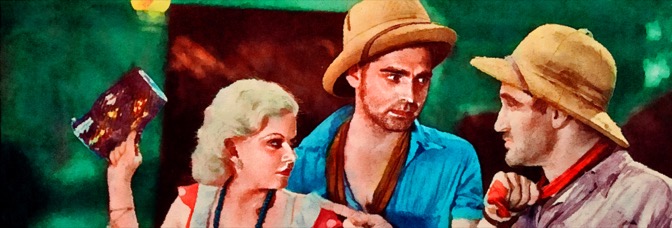I’m not sure how much would be different about Red Dust if the film weren’t so hideously racist, particularly when it comes to poor Willie Fung (as the houseboy), but at least it wouldn’t go out on such a nasty note. Especially since the finale, despite being contrived, at least plays to the film’s strengths, which it had forgotten for a while.
Red Dust’s strengths are Jean Harlow and, at least when they’re bantering, Clark Gable. It’s not about the performances being better than any of the others—all the performances are good, with the exception of Fung, but… that one isn’t his fault—it’s just Harlow’s the most likable person in the picture. Sometimes it seems like she’s the only likable person, just because the other likable folks are offscreen somewhere, sent away so Gable can seduce married woman Mary Astor.
The film starts with Harlow ending up at Gable’s Vietnam rubber plantation. Well, actually, it starts with Gable and occasional sidekick (and likable folk) Tully Marshall overseeing the plantation. Lots of quick expository action, lots of casual racism involving the workers (it’s okay, though, because Gable works hard like a white alpha male should—though it turns out he inherited the plantation from his dad and seemingly grew up there so, wow, what a dick), then in comes Harlow. After some good banter, they end up canoodling. Harlow’s hiding out from some problems in Saigon, where she’s probably a working girl. Red Dust is Pre-Code but it’s still 1932 and all.
So once she and Gable hook up, the movie jumps ahead three weeks or so. They’ve been shacked up, but it’s time for her to go. She’s sweet on Gable, even though he’s an abject asshole; he doesn’t even seem to notice. Red Dust is great for passive displays of not just white man’s “burden” but also toxic masculinity and privilege. John Lee Mahin’s script is rather unaware of itself. Not blissfully, it’s not an intentional move on Mahin’s part, it’s just baked in no one would ever think about those things, which almost plays to its favor. Once Gable’s doing nothing but romancing Astor, well… if the script were avoiding anything, it’d be hard to tolerate Gable.
Anyway. After the jump ahead, Astor and husband Gene Raymond. Raymond’s Gable’s new engineer, Astor is the wife he wasn’t supposed to bring. Raymond arrives ill, so Gable and Astor have to nurse him back to health. Only then Harlow shows back up because of plot contrivance—albeit a logical enough one—and Gable doesn’t want her contaminating blue blood Astor. Gable’s got to figure out how to seduce Astor while keeping it not just from Raymond, but somewhat from Harlow as well. At least, he doesn’t want Harlow messing it up for him.
The way it plays is celibate hard-ass Gable discovers he likes having a woman around with Harlow, then wants to “trade up” for Astor.
Meanwhile, once Astor arrives, Red Dust is hers for a while. All through her perspective, including the tour of the rubber plantation and how rubber is made. The tour comes relatively late in the picture, given rubber-making is most of what Gable and Marshall talk about it. It’s a rather nice narrative move from Mahin and director Fleming in a film where there really aren’t many nice narrative moves. The script’s not clumsy, just leaden. Gable’s charm plays a lot differently as he manipulates and seduces Astor (and abuses and neglects Harlow).
There’s an obvious finish to all of it, which doesn’t require anything but to completely flush the idea of Astor having a character. Then, after the first flush, when she’s reset, the script flushes her again, taking what starts as a role with quite a bit of potential and reducing it to plot fodder.
Acting-wise, Harlow’s the best, just because she doesn’t go through any character development contortions. When Gable’s not being a complete bastard, he’s good. He’s always fine with the physical aspects of the role, but when he’s in asshole mode he’s just muscling through the material not acting it. Fleming’s no help with directing his actors and they need it with Mahin’s script.
Astor’s better at the start than the finish. In theory she’s got the best character arc, but it all happens off-screen. The film skips over some crucial scenes for her character development (Red Dust runs a somewhat long eighty-two minutes as the scenes with Astor and Gable eventually get tedious). Raymond’s okay as the beta male husband. Not sure if we’re supposed to consciously notice Astor’s taller than him or not.
Marshall’s great as the sidekick (when he’s in the picture) and Donald Crisp is surprisingly good as Gable’s other overseer. Surprisingly because he’s usually passed out drunk in the picture and doesn’t get but two scenes with any activity. But he’s real good in them.
Fleming’s direction is okay. Red Dust is a stage adaptation and occasionally feels like it, but once the monsoon season starts, there’s always something inventive going on visually. Harold Rosson’s photography is excellent. Blanche Sewell’s editing is not, though it appears Fleming didn’t give her enough coverage. And it’s not bad editing, it’s just not excellent editing. It’s fine. Technically, Red Dust is a success.
Dramatically, it’s incredibly problematic (even without the contrivances and frequent, casual racism). The film wastes Gable’s potential and limits Harlow’s.
This post is part of the Jean Harlow Blogathon hosted by Samantha of Musings of a Classic Film Addict and Virginie of The Wonderful World of Cinema.


Leave a Reply to Erica D.Cancel reply